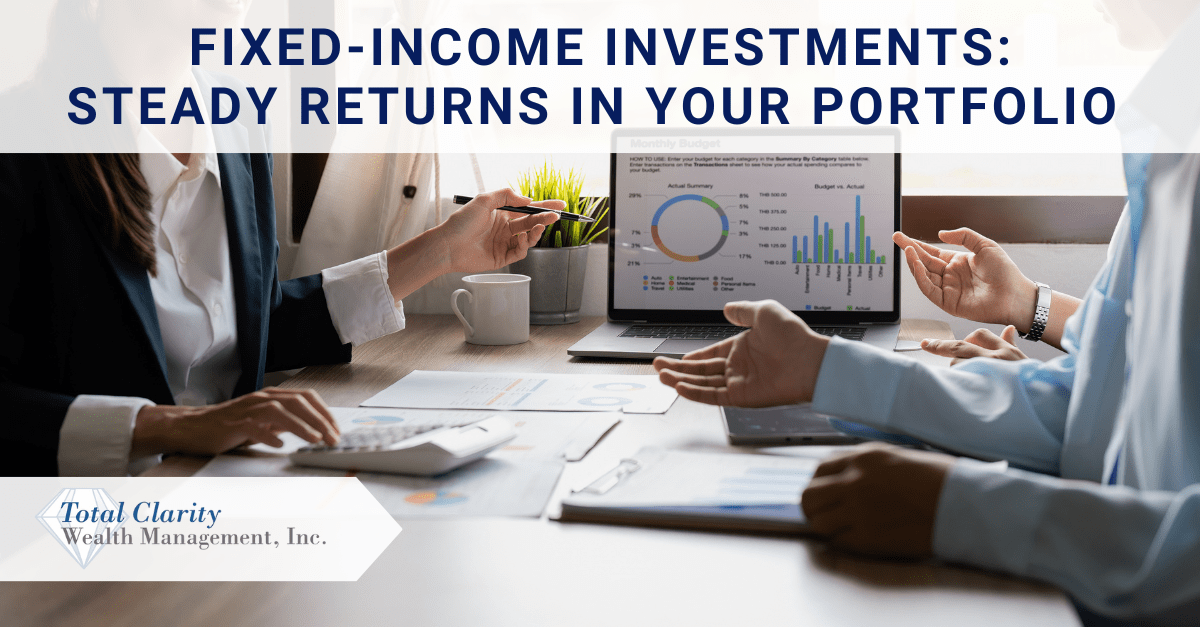Fixed-Income Investments: Pursuing Steady Returns in Your Portfolio
Building a diversified investment portfolio is like creating a well-balanced meal. You need a mix of various ingredients in seeking to ensure you receive all the essential nutrients. One such crucial ingredient for your investment portfolio may be fixed-income investments. In this article, we'll delve into the world of fixed-income investments, understanding what they are, how they work, and why they are a vital component for pursuing regular returns in your investment portfolio.
The Role of Fixed-Income Investments
Fixed-income investments play a pivotal role in providing expected returns in an investment portfolio. If used appropriately, they can act like the steady backbone that helps balance the overall risk.
What Are Fixed-Income Investments?
Fixed-income investments are debt securities that pay regular interest to investors. They include bonds, certificates of deposit (CDs), treasury securities, and more.
Types of Fixed-Income Investments
There is a wide array of fixed-income investments to choose from, each with varying risk and return profiles. Understanding these types helps you tailor your portfolio to your financial goals.
How Fixed-Income Investments Work
Fixed-income investments work by loaning your money to an issuer in exchange for regular interest payments and the return of your principal amount at maturity. This regular income stream is why they are called "fixed income."
Benefits of Including Fixed-Income Investments
Fixed-income investments can offer several advantages, including capital preservation, reliable income, and portfolio diversification. They act as a counterbalance to the volatility of equity investments.
Risks and Considerations
While fixed-income investments are generally lower risk than stocks, they are not entirely risk-free. Understanding potential risks, such as interest rate risk and credit risk, is essential. For example, bonds are subject to market and interest rate risk if sold prior to maturity. Bond values will decline as interest rates rise and bonds are subject to availability and change in price.
Diversification: The Key to a Balanced Portfolio
Diversifying your portfolio with a mix of asset classes, including fixed-income investments, spreads risk and seeks to smooth market returns.
How to Start Investing in Fixed-Income Assets
Getting started with fixed-income investments involves selecting the right mix of bonds, considering factors like your risk tolerance and investment horizon. It's essential to work with a financial advisor to tailor your choices.
Monitoring and Adjusting Your Fixed-Income Portfolio
Periodic review and adjustment of your fixed-income portfolio are crucial to ensure it aligns with your financial goals and risk tolerance. This ensures you continue to pursue regular returns.
The Dependable Foundation of Your Portfolio
Fixed-income investments are the dependable foundation of your investment portfolio. They provide regular, consistent income, and serve as a counterbalance to the potential volatility of other asset classes. By understanding their role, selecting the right mix, and periodically reviewing your portfolio, you can seek to build a well-balanced and resilient investment strategy that stands the test of time.
FAQs
Q1: What are fixed-income investments?
Fixed-income investments are debt securities that pay regular interest to investors. They include bonds, certificates of deposit (CDs), treasury securities, and more.
Q2: What is the role of fixed-income investments in a portfolio?
Fixed-income investments provide regular income, and diversification in an investment portfolio. They help balance overall risk.
Q3: What are the benefits of including fixed-income investments in a portfolio?
Benefits can potentially include capital preservation, consistent income, and counterbalancing the volatility of equity investments.
Q4: What are the risks associated with fixed-income investments?
Risks include interest rate risk, credit risk, and inflation risk. It's important to understand these risks when investing in fixed-income assets.
Q5: How do I start investing in fixed-income assets?
Starting involves selecting the right mix of bonds based on your risk tolerance and financial goals. It's advisable to work with a financial advisor to make informed choices.
Important Disclosures
Content in this material is for general information only and not intended to provide specific advice or recommendations for any individual.
There is no guarantee that a diversified portfolio will enhance overall returns or outperform a non-diversified portfolio. Diversification does not protect against market risk.
CDs are FDIC insured to specific limits and offer a fixed rate of return if held to maturity, whereas investing in securities is subject to market risk including loss of principal.
Government bonds and Treasury bills are guaranteed by the US government as to the timely payment of principal and interest and, if held to maturity, offer a fixed rate of return and fixed principal value.

